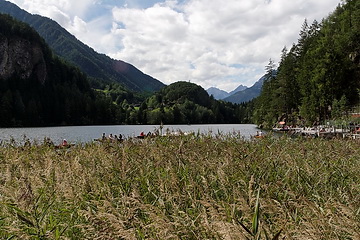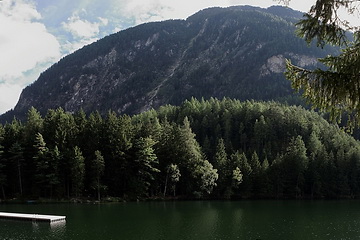Ötztaler Alpen: Piburger See
Der Piburger See ist eines der ältesten Naturschutzgebiete Österreichs und wurde bereits 1929 zum Naturdenkmal erklärt. Heute umfasst das Landschaftsschutzgebiet Achstürze - Piburger See die Umgebung des Sees sowie die Achstürze und den Habicher See. Ursache für die Entstehung des Piburger Sees war ein gewaltiger Bergsturz nach der letzten Eiszeit, der das das parallel zum Ötztal verlaufende Piburger Tal an seinem Südende aufstaute. Der ca. 800 m lange, 250 m breite und bis zu 25 m tiefe See ist durch seinen landschaftlich reizvolle Lage und die relativ hohen Wassertemperaturen im Sommer ein beliebtes Ausflugsziel und ein ganz besonderer Lebensraum für viele Tier- und Pflanzenarten.
Lake Piburg is one of the oldest conservation areas in Austria and a natural monument since 1929. Today the protected area called 'Achstürze - Piburger See' does not only include the lake but also the rapids of the Ötztaler Ache (Achstürze) and Lake Habich. The reason for the formation of Lake Piburg was an enormous landslide which dammed the Piburg Valley at its southern end just after the most recent glacial period. The resulting lake is about 800 m long, 250 m wide and up to 25 m deep and a popular destination because of the lovely scenery and its the warm temperature in summer which is quite unusual for an alpine lake. It is also a very special biotope for many species of plants and animals.
Am einfachsten erreicht man den See vom Parkplatz im 950 m hoch gelegenen Weiler Piburg. Am gegenüber liegenden Ende befindet sich die Badeanstalt, wo auch der Abstieg zur Wellerbrücke und den Achstürzen beginnt. Immer ein beliebtes Fotomotiv: der Acherkogel (3008 m) der sich im Wasser des 913 m hoch gelegenen Sees spiegelt.
From Piburg (950 m) it is just a short walk to the banks of the lake. The descent to the Weller Bridge and the rapids of Ötztaler Ache starts on the opposite side near the swimming baths. The summit of Acherkogel (3008 m) is reflected by the waters of the lake, a very common motif for photographers.
Die Ufer des Piburger Sees sind meist steil und teils felsig, nur an den Enden findet man flachere Buchten.
The banks of Lake Piburg are mostly steep and partly rocky. Flatter parts can only be found at the ends of the lake.
Am südseitigen Ufer des Sees findet man auch die Überreste des Felssturzes. Die riesigen Felsblöcke sind dicht mit Moosen und Farnen bedeckt und geben dem Wald eine ganz besondere Note.
The remainders of the landslide are still visible on the southern banks of the lake. The enormous rocks are overgrown by moss and fern providing it with a special touch.
Orchideen waren im August nicht zu finden aber jede Menge Pilze.
Blooming orchids are very rare in August but we found quite a lot of mushrooms instead.

